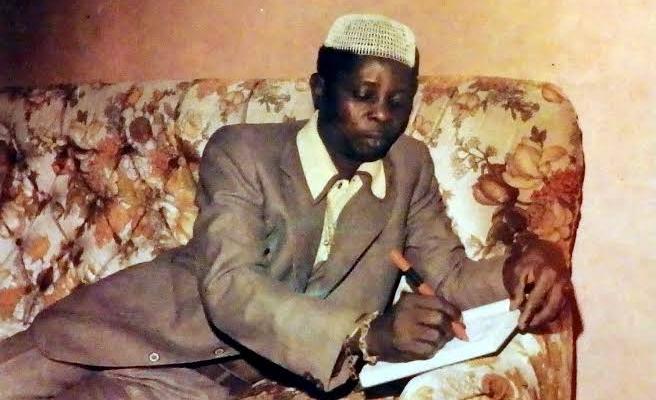AMAA 2024: How It Happened
11 hours ago



Dark Mode
Turn on the Lights

If you don’t know the name Ayinla Omowura, that is probably because of his untimely but predicted death and the fact that his genre of music was inspired by his Egba dialect which has been difficult to translate over the last 30 years. Even though his music was particular to the time it was made, […]

If you don’t know the name Ayinla Omowura, that is probably because of his untimely but predicted death and the fact that his genre of music was inspired by his Egba dialect which has been difficult to translate over the last 30 years. Even though his music was particular to the time it was made, his social awareness is noted in this day and age.
He was born Waheed Ayinla Gbogbolowo in the late ‘30s in Abeokuta, Ogun State to a blacksmith father and trader mother. It is said that he spent his adolescent years working with his father. Some sources claim that he was once a commercial bus driver, like most of the people his age at that time. Much of his childhood isn’t available publicly as there aren’t authentic records. His life only became important to document when he began his music career. Ayinla’s moniker Ayinla Omowura which means Ayinla Son of Wura was coined from his mother’s name. He also went by several aliases including Eegun Mogaji, Hadji Costly, Alujannu Elere and Agbejapa Oba.
Life As A Social Commentator
Ayinla turned to music in the early ‘50s after he was discovered by Adewole Alao Oniluola, who later became his lead drummer. He started as an apprentice in Olalomi, an Apala variant, which was popular across Nigeria and West Africa. His musical path took a different turn in 1970 when he joined the EMI NIGERIA record label and released his song Ajat Of’ Oju D’ejo in June of that same year.
He lived during Nigeria’s second republic that saw a long list of developments and he was not afraid to share his opinions on these changes. He commented on the politicians, in the song Eyin Oselu wa (Our Politicians) advising the politicians to stop their bickering and tend to the needs of the nation. His lyrics, translated to English, say, “Leader: please, be patient let a man sight a snake and allow a woman to kill it then what do we want? it’s for the snake not to escape! That’s what we want.” Ayinla who spoke mostly in proverbs used the complementary effort of the man and woman in killing the snake to explain how the country can only prevail through nationhood.
As an artist, he stood out as a critic and social commentator serving as the people’s mouthpiece lamenting on their behalf to the leaders with puns and proverbs. He also kept the masses informed whenever there was a new government policy. His lyrics often touched on the current affairs of the country at the time.
In the song Orin Owo Ile Eko (Lagos Rent Edict), he informs his listeners of the developments being made by the federal government, advising the local landlords to follow suit. “Some news just reached me concerning federal tenement rates … let’s draw close to hear,” he sang. These lyrics reference the former governor of Lagos state Mobalaji Johnson’s masses-oriented programme edict reducing the tenement rates to help citizens of lower classes.
In 1974, the regime of General Yakubu Gowon created the Jerome Udoji Wage Commission to look into the demands of Nigerian workers for a pay rise. Reacting to the news in the record Ire wole de (Owo Udoji) meaning, Goodness Has Come (Udoji’s Money), Omowura sang, “goodness has come, let’s dance for joy for our govt. workers in Nigeria, it is said that new increment has come. I’m happy for them, I too rejoice with them. New incomes has come, Udoji raise is a must for workers. God, let them derive benefit from it.”
Apart from social issues, the popular artist also used his music to criticise bleaching and promiscuity among women while pushing for a better society.
Personal Life & Predicted Death
Ayinla was known for a few things; his signature fancy agbada, gold jewellery, love for women who owned beer parlours and his spirituality. He expressed his self-belief and assurance in his songs, speaking clearly of his “enemies” inability to see him fail.
His short temper also earned him a reputation. He fought with other musicians like Ayinde Barrister, Fatai Olowonyo, Yesufu Olatunji, Dauda Epo Akara and even the famous Haruna Ishola, who popularised the Apala genre. This temper and tendency to get into fights led to his death.
Ayinla, who had predicted his death six months before the event, met his end in a beer parlour in Abeokuta at the hands of his band member. The famous artist passed away in 1980 from a cerebral haemorrhage after his band member hit him on the head with a beer mug. He was 47 years old.
He had a short but impactful musical career as one of the most impactful social commentators of his generation. He also goes down in Nigeria’s music history as the man who redefined the Apala genre of music that was popularised by Ishola.
Legacy
The music scene after Ayinla’s death was dominated by artists like Ayinde Barrister who duplicated his style. 40 years later, an album titled Anigilaje was made in his honour. The project was done by his daughter Halimat Omowura, drummer who was 95 at the time, Sefiu Alao, a Fuji musician and Oyetola Oniwide, a professor and radio presenter.
His house in Itoko, Abeokuta was renovated by Ibikunle Amosun, former governor of Ogun State at the same time. The artist also got imortalised in a biography: Ayinla Omowura: Life and Times of an Apala Legend published by lawyer and journalist, Festus Adedayo last year.
This year, a movie titled Ayinla is about to be released. Produced by Jade Osiberu and directed by veteran filmmaker, Tunde Kelani, the film tells the story of the legendary Apala artist.
Ayinla died many years ago but he continues to live on through his music and legacy!

1 Comments
Add your own hot takes